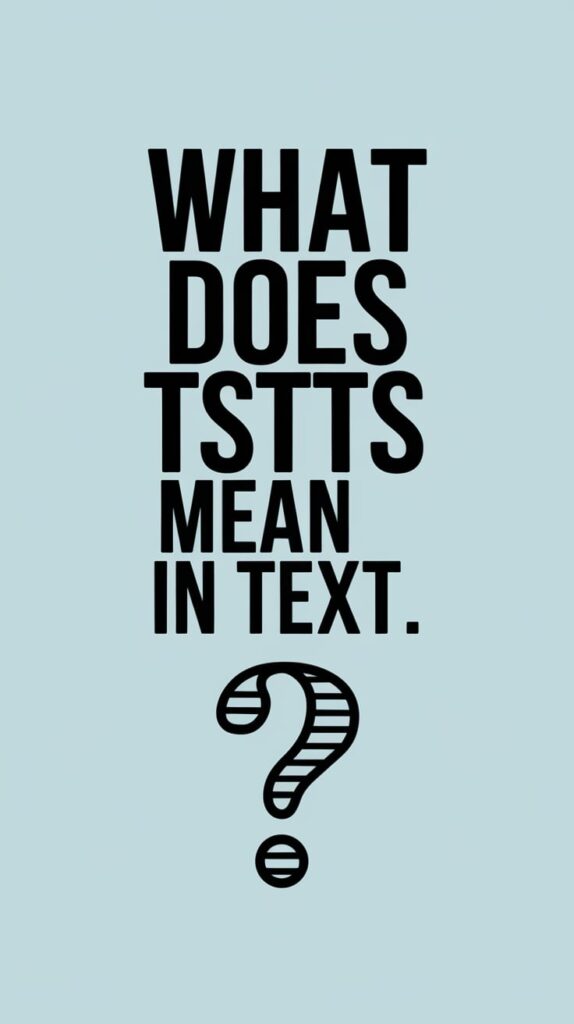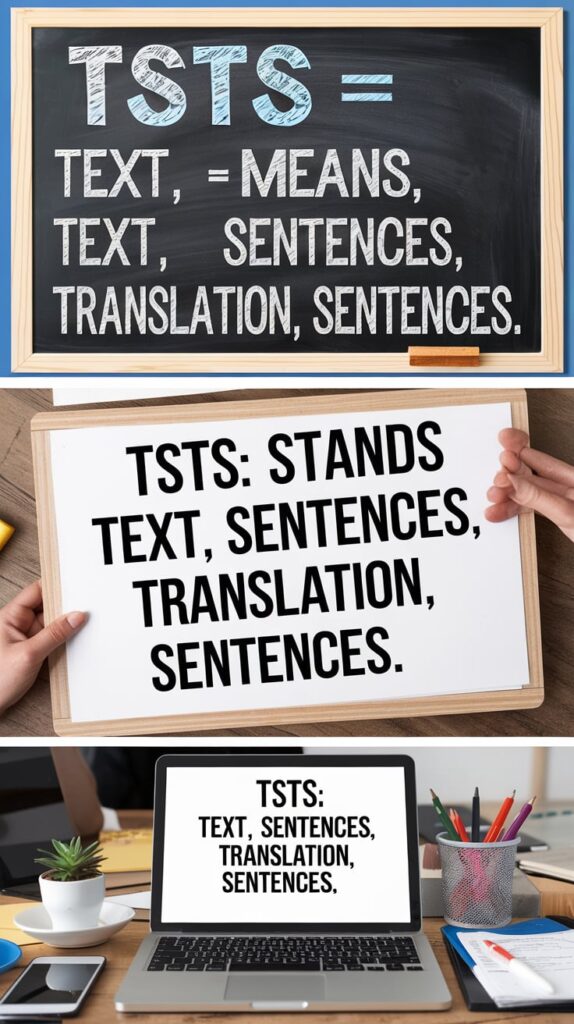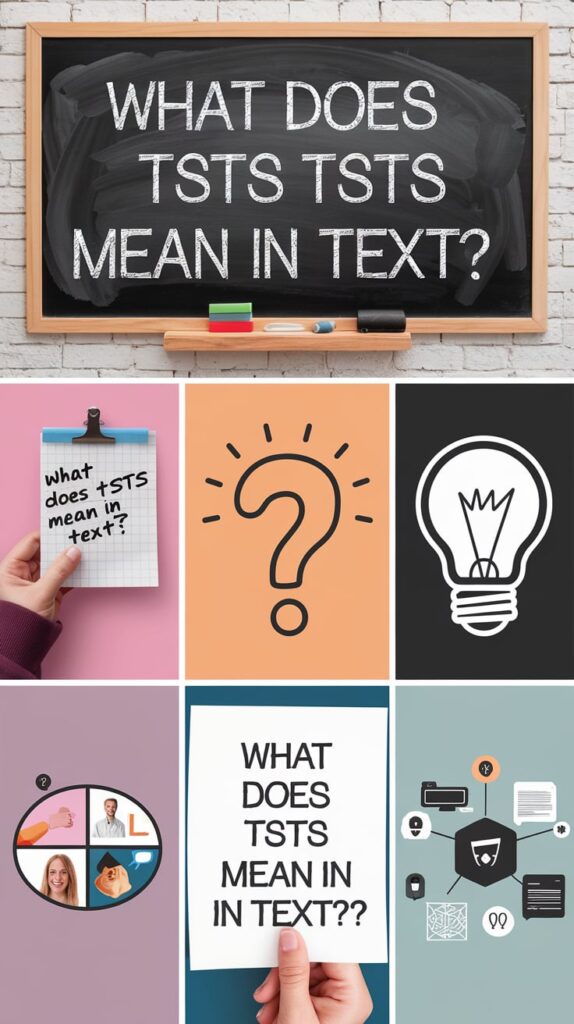Ever seen “tsts” in a text or social media post and wondered what it means? In the fast-paced world of texting, slang and abbreviations like tsts have become essential tools to express humor, sarcasm, or even mild frustration all in just a few letters. Short, playful, and versatile, tsts can turn a simple message into a witty, relatable, and expressive statement.
Whether you’re chatting with friends, teasing a crush, or participating in a lively group chat, understanding tsts ensures your messages land exactly as intended.
read more : What Does “Iicyify” Meaning? Guide with Examples – Grammar Beacon

What Does Tsts Mean in Text?
At its core, “tsts” stands for “too smart to talk small“ This phrase embodies a sense of wit, intelligence, and perhaps a hint of sarcasm. It’s often employed in casual conversations,
particularly among younger demographics on platforms like TikTok, Snapchat, and Instagram. Understanding the meaning behind “tsts” enhances our ability to engage effectively in texting culture.
A Closer Look at Tsts
The term “tsts” serves various functions depending on the context. Here’s a breakdown of its primary meanings:
- Playful Banter: In casual conversations, “tsts” can inject humor and playfulness.
- Sarcasm: It often conveys a sarcastic tone, particularly when responding to a question or comment that seems obvious or silly.
- Dismissiveness: Sometimes, “tsts” may indicate that the speaker finds a topic trivial or unworthy of serious discussion.
By grasping these meanings, we can better understand how to incorporate “tsts” into our texting vocabulary.
read more : Plural of Chief – Grammar Beacon
Use Cases of Tsts mean in Text
The versatility of “tsts mean in text” makes it an appealing addition to informal conversations. Let’s explore several use cases that illustrate its range.
Casual Conversations
In everyday texting, “tsts” often appears in light-hearted exchanges.
Example 1:
Friend: “Why didn’t you respond to my last message?”
You: “Tsts! I was busy living my best life! ��”
In this scenario, “tsts” emphasizes a carefree attitude, turning what could be an awkward moment into a playful interaction.

Sarcasm and Irony
Sarcasm is one of the hallmark features of “tsts.” When someone uses it in response to a seemingly obvious statement, it can highlight their cleverness.
Example 2:
Friend: “Did you actually think you’d pass that test without studying?”
You: “Oh, totally! I’m tsts, remember? ��”
Here, the sarcasm underscores the humor in the exchange, making it clear that you’re joking about your studying habits.
Expressing Frustration
Sometimes, “tsts” serves to express annoyance or disappointment, especially when paired with appropriate emojis.
Example 3:
Friend: “You missed the team meeting again!”
You: “Tsts! I had a prior commitment. ��”
In this context, “tsts” indicates your frustration, and the accompanying emoji reinforces that feeling.
Flirting and Playfulness
In flirtatious conversations, “tsts” can create a playful atmosphere.
Example 4:
Crush: “You’re acting like you know everything.”
You: “Well, I’m tsts, aren’t I? ��”
Here, using “tsts” not only adds a teasing element but also keeps the interaction light and enjoyable.
Group Chats
In group chats, “tsts” can be a great way to contribute to the banter while signaling your awareness of the ongoing conversation.
Example 5:
Group Member: “Can you believe she forgot the date?”
You: “Tsts! That’s classic her. ��”
This use showcases the fun side of “tsts” and demonstrates your participation in the group dynamics.
read more : Vicious vs Viscous – Grammar Beacon
Technical Interpretations
- Twin State Technical Services: Refers to a company providing various technical solutions.
- Transaction Switching & Transport Service: A term commonly used in the telecommunications and IT industries.
- Time Space Time Space: A playful phrase often found in science fiction discussions.
These alternate meanings illustrate that “tsts” is not limited to casual texting; it has applications in more specialized contexts.
Sound Representation
In certain situations, “tsts” can represent a sound effect, typically used to convey disappointment or annoyance. The sounds “tsss” or “tsssss” can accompany it, enhancing its emotional impact.
Example:
If someone makes a mistake, you might respond with, “Tsts! That’s not what we agreed on.” This sound representation adds a layer of expressiveness to your message.
Tsts and Emojis: Enhancing Communication
Emojis play a critical role in modern texting, adding layers of meaning and emotional nuance. When combined with “tsts,” they can clarify intent and enhance the overall message.
Here’s a breakdown of emojis commonly associated with “tsts” and their meanings:
| Emoji | Meaning |
| �� | Coolness or confidence |
| �� | Sarcasm or irony |
| �� | Frustration or annoyance |
| �� | Hope for a positive outcome |
Examples of Emoji Use with Tsts
Expressing Coolness:
“I’m tsts ��, so let’s not waste time!”
Adding Sarcasm:
“Oh sure, I definitely meant to forget that. Tsts! ��”
Showing Frustration:
“Tsts ��, why do I even bother asking?”
The strategic use of emojis enhances the emotional weight of “tsts,” making your communication clearer and more engaging.
read more : What Does Wytb Meaning in Texting? – Grammar Beacon

Things You Should Consider When Using Tsts
Incorporating “tsts” into your texting vocabulary can add flair, but there are several factors to keep in mind to ensure effective communication.
Know Your Audience
Understanding your audience is crucial. Not everyone may be familiar with the term, so consider their familiarity before using it. If your texting partner isn’t well-versed in slang, it might lead to confusion.
Tone and Context
The emotional tone behind “tsts” can vary widely depending on context. Using it in a serious discussion may come across as dismissive or sarcastic, which could lead to misunderstandings. Gauge the situation and adjust your language accordingly.
Clarity is Key
If there’s any chance your conversation partner might misinterpret your intent, consider providing additional context. This can help ensure your message is understood as you intended.
Cultural Sensitivity
Different cultures have varying interpretations of slang and informal language. Be mindful of the cultural background of your audience, as the tone and meaning of “tsts” might not translate well in every context.
The Evolution of Slang in Texting
The landscape of texting language is constantly evolving. Slang terms like “tsts” emerge from the need for brevity and expressiveness in communication. Here’s a brief look at how texting language has transformed over the years.
The Rise of Abbreviations
With the advent of mobile texting, character limits became significant constraints. This limitation gave birth to a plethora of abbreviations and acronyms, making “tsts” part of a larger linguistic trend.
Social Media Influence
Platforms like Twitter and Instagram have accelerated the spread of slang. Users often adopt and adapt phrases for humor or to resonate with their audience. The virality of certain phrases can lead to widespread adoption, as seen with “tsts.”
Generational Differences
Younger generations are more inclined to use slang in their daily communications. Understanding these terms is essential for older generations to engage meaningfully in conversations.
This generational gap highlights the importance of staying updated on evolving slang.
Globalization of Slang
As texting transcends geographical boundaries, slang like “tsts” can gain international recognition. Different cultures might interpret it in unique ways, adding richness to its usage.
This globalization allows for more dynamic and diverse communication styles.
How to Incorporate Tsts into Your Texting Style
Now that we’ve explored what “tsts” means and how to use it, let’s look at ways to seamlessly incorporate it into your texting style.
Be Authentic
When using “tsts,” it’s crucial to remain true to your voice. Authenticity resonates well in communication. If sarcasm or playfulness is part of your personality, then using “tsts” will come naturally.
Match the Mood
Understanding the mood of the conversation is vital. If the atmosphere is light and humorous, introducing “tsts” can enhance the fun. Conversely, in serious discussions, it may be best to avoid slang altogether.
Experiment with Different Contexts
Try using “tsts” in various scenarios to see how it fits. Whether you’re chatting with friends, flirting, or participating in group discussions, experimenting can help you refine your texting style.
Be Mindful of Repetition
While it’s easy to fall into the habit of using “tsts” frequently, overusing any slang can dilute its impact. Use it judiciously to maintain its effect and keep conversations fresh.
The Psychological Impact of Slang in Texting
Understanding the psychological implications of using slang like “tsts” can provide deeper insights into communication dynamics.
Connection and Identity
Slang can foster a sense of belonging. When people use terms like “tsts,” they create a shared language that strengthens social bonds. This connection can
lead to greater engagement and camaraderie among peers.

Emotional Expression
Slang allows for nuanced emotional expression. Using “tsts” can help convey complex feelings, such as humor, sarcasm, or frustration, in a succinct way. This efficiency makes it a valuable tool for emotional communication.
Influence on Perception
The use of slang can influence how others perceive you. Employing terms like “tsts” can project a youthful, relatable image, while avoiding slang may be viewed as more formal or reserved.
Consider how your texting style aligns with the impression you want to convey.
FAQs About Tsts
What does tsts mean in texting?
Tsts stands for “too smart to talk small”. It’s often used to show wit, sarcasm, playfulness, or mild annoyance in casual texting.
How do you use tsts in a sentence?
Example: Friend: “You forgot to reply!” You: “Tsts!** I was busy living my best life! 😎”
What emojis go with tsts?
Emojis like 😎, 🙃, 😤, and 🤞 enhance tsts by showing sarcasm, coolness, or frustration.
Can tsts be used professionally?
Tsts is informal slang, so it’s best reserved for casual conversations with friends or peers, not professional emails or messages.
Does tsts have other meanings?
Yes, in technical or specialized contexts, TSTS can mean Twin State Technical Services, Transaction Switching & Transport Service, or Time Space Time Space in sci-fi discussions.
Conclusion:
Tsts is more than just a texting abbreviation it’s a fun, expressive, and versatile way to communicate in the digital world. Whether you’re joking with friends, adding playful sarcasm, or sharing frustration, tsts paired with the right emojis can make your messages lively and relatable.
Mastering slang like tsts keeps your texting fresh, engaging, and culturally in tune, making every conversation more fun and expressive.

James Logan is a seasoned blogger and language enthusiast behind Grammar Beacon. With years of experience in grammar and writing, James shares his expertise through insightful and engaging content. His passion for clear communication and linguistic precision shines in every post, making complex grammar concepts accessible and enjoyable for readers. Follow James for expert advice and tips to refine your writing skills.







